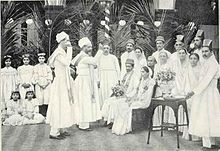
Depiction: Ahab's harpooneer Fedallah, about to reveal his prophecy. He's crouched on the bow of the Pequod at night. In the waves before him, we see the top of a dead whale, pole stuck in its blowhole topped by a lit lantern, encircled by sharks.
Text: Chapter 117- The Whale Watch
The waif-pole was thrust upright into the dead whale’s spout-hole; and the lantern hanging from its top, cast a troubled flickering glare upon the black, glossy back, and far out upon the midnight waves, which gently chafed the whale’s broad flank, like soft surf upon a beach.
Ahab and all his boat’s crew seemed asleep but the Parsee; who crouching in the bow, sat watching the sharks, that spectrally played round the whale, and tapped the light cedar planks with their tails.
Comments: Although Melville was notably progressive for his time in some respects, Moby Dick contains some historically typical racist language and stereotypes. Fedallah, the second prophet in the book, doesn't get to be much more than a phantasmic caricature of mystical, inscrutable Orientalism, his single conversation limited to sharing his prophetic dream of doom. His connection to the subconscious makes him an appropriate figure for this card.
 |
Alternate Depiction: Ahab, in his quarters, seated, eyes closed, rapt in thought. He is constantly pondering metaphysics and questioning the nature of reality: he demands to "strike through the mask" of human perception (Chapter 36- The Quarter-Deck). Also, though he initially relies on charts and navigational equipment like the quadrant to track his prey, ultimately Ahab relies on his own instinct. See below for an image from the 2011 television miniseries (which obviously would NOT be copied for a tarot deck!) that is quite evocative of the High Priestess.
 |
| William Hurt as Ahab in the 2011 miniseries of Moby Dick/Starz Encore |
No comments:
Post a Comment